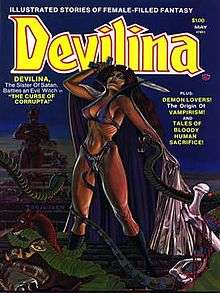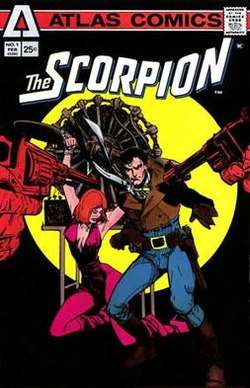Atlas/Seaboard Comics
Atlas/Seaboard is the term comic book historians and collectors use to refer to the 1970s line of comics published as Atlas Comics by the American company Seaboard Periodicals, to differentiate from the 1950s' Atlas Comics, a predecessor of Marvel Comics. Seaboard was located on Fifth Avenue in Manhattan, New York City.
 A variant of the logo used for Atlas/Seaboard comics. | |
| Industry | Publishing |
|---|---|
| Fate | Dissolved |
| Founded | June 1974 |
| Founder | Martin Goodman |
| Defunct | 1975 |
| Headquarters | 717 Fifth Avenue, Manhattan, New York City, New York , |
Key people |
|
| Products | Comic Books |
| Owner | Martin Goodman |
| Website | atlasarchives |
History
Company creation
Marvel Comics founder and Magazine Management publisher Martin Goodman left Marvel in 1972, having sold the company in 1968. He created Seaboard Periodicals, which opened its office on June 24, 1974,[1] to compete in a field then dominated by Marvel and DC Comics. Goodman hired Warren Publishing veteran Jeff Rovin to edit the color comic-book line,[2] and writer-artist Larry Lieber, brother of Marvel editor-in-chief Stan Lee, as editor of Atlas' black-and-white comics magazines.
Rovin said in 1987 he became involved after answering an ad in The New York Times.
I was working for [Warren Publishing founder] Jim Warren, running his mail-order division, Captain Company, and just starting to edit [the black-and-white horror-comics magazine] Creepy [and] I'd edited comics for DC and Skywald.... Several weeks after answering the ad, I receive a call from Martin Goodman.... I was one of several people Martin interviewed, and I got the job because I'd had experience not only in comics but in mail order, the latter of which was to contribute significantly to Seaboard's cash flow. Sharing editorial duties on the comics was writer-artist Larry Lieber, whom Martin had long wanted to transplant from under the shadow of Larry's brother.... Larry ended up handling about a quarter of Atlas' output — primarily the police, Western [and] war [comics], and color anthologies of horror stories.[3]
Lieber later became editor of the color comics following Rovin's departure. Steve Mitchell was the comics' production manager, and John Chilly the black-and-white magazines' art director. Goodman offered an editorial position to Roy Thomas, who had recently stepped down as Marvel Comics editor-in-chief, but Thomas turned it down, recalling in 1981 that, "[I] didn't have any faith in his lasting it out. The field was too shaky for a new publisher."[4]
Lieber recalled in a 1999 interview:
When I went there, Martin put out two kinds of books. He was putting out color comics, and he was also going to put out black-and-white comics like Warren and Marvel. Now, I knew nothing about black-and-white comics, right? My only experience was in the color comics. Jeff Rovin came from Warren, and he knew nothing about color comics. Martin unfortunately put Jeff in charge of all the color comics and put me in charge of the black-and-white books. It was an unfortunate thing, and basically what happened was that Jeff's books didn't turn out so well... Martin had to pay high freelance rates, because otherwise nobody would work for a new and unproven company... It didn't work out too well, and Jeff finally left angrily or something, and I had to take over all his books. At this point, business was bad, and I tried to do what I could. One of the things I had to do was to cut rates and tell people they were going to make less money, which was not an enviable position.[5]
Comic-book collectors and others began using the term "Atlas/Seaboard" to differentiate these 1970s Atlas Comics from the 1950s' Atlas Comics, publisher Goodman's predecessor of Marvel Comics.[6]
Creators' rights pioneer
Atlas/Seaboard offered some of the highest rates in the industry, plus return of artwork to artists and author rights to original character creations.[7] These relatively luxurious conditions attracted such top names as Neal Adams, Steve Ditko, Russ Heath, John Severin, Alex Toth and Wally Wood, as well as such up-and-coming talents as Howard Chaykin and Rich Buckler.
A total of 23 comics titles and five comics magazines were published before the company folded in late 1975. No title lasted more than four issues. Of the characters, Chaykin's Scorpion would inspire his Dominic Fortune at Marvel[8] and Rich Buckler's Demon Hunter would inspire his Devil-Slayer at Marvel.[9]
Chip Goodman
Some reports at the time suggested Goodman was angered that Cadence, the new Marvel owners, had reneged on a promise to keep his son, Charles "Chip" Goodman, as Marvel's editorial director. Marvel and Atlas writer Gary Friedrich recalled: "I never really felt that [Martin] did it for that reason. I think he did it to make money and that he thought with Larry in charge and paying good rates that he could do it. Now, he probably wouldn't have minded if it would have taken a bite out of Marvel's profits, but I don't think it was done out of revenge. I think Martin was too smart for that".[10] Marvel art director John Romita, however, believed, "Chip was supposed to take his place. But that part of it must not have been on paper, because as soon as Martin was gone, they got rid of Chip. That's why Martin started Atlas Comics. It was pure revenge".[11]
Although Chip Goodman was also in charge of the Seaboard comics, he was a "lightweight" in making decisions about them, according to Rovin.[6] Historian and one-time Marvel editor-in-chief Roy Thomas recalled, "One of the problems was just being Martin Goodman's son. I don't think that Martin respected Chip very much—he put Chip in charge but would treat him with less than benign contempt in front of other people. Martin was a little cruel sometimes".[12]
This father-son conflict was fictionalized by a Magazine Management staffer, Ivan Prashker, who wrote a short story with a thinly disguised, unflattering portrait of a character based on Chip Goodman. When this story, "The Boss's Son," was published in the February 1970 issue of Playboy, Prashker expected he might be fired, but instead, wrote comics historian Jon B. Cooke, he "was rewarded with his own editorship of a magazine as Martin was apparently more impressed that one of his staffers was published in the premier men's magazine than with any insult made to his son".[13]
Revival
Circa 2010, Martin Goodman's grandson Jason Goodman announced a partnership with Ardden Entertainment to relaunch Atlas Comics starting with two "#0" issues featuring the Grim Ghost and Phoenix.[14] With another character, Wulf the Barbarian, they were the stars of a miniseries, Atlas Unified, announced in September 2011 for publication that November.[15]
Jason Goodman's Nemesis Group Inc. belatedly discovered that one Jeffrey Stevens had acquired the trademark "Atlas Comics" for comic books in October 2005. Nemesis filed suit in 2010, arguing that Stevens had no demonstrated use of the trademark, and on March 13, 2012, the Trademark Trial and Appeal Board allowed the case to proceed to trial. The Board ultimately ruled against Goodman, and on August 10, 2014, Stevens assigned the trademark to Dynamite Characters LLC. In February 2016, Nemesis Group filed a new Atlas Comics logo at the United States Patent and Trademark Office for a possible challenge to Dynamite's registration.[16]
A new Atlas company was formed by May 2019 with SP Media Group owning a majority and Goodman retaining an interest. The new company purchased the Atlas characters and IPs from Nemesis Group that month. A number of deals to bring the characters to theaters starting in 2021 with one release each year with budgets starting at $60 million were also announced. Akiva Goldsman and his Weed Road Pictures were hired to run a writers room to develop 10 story outlines to select one for further development and production. Paramount Pictures was signed on in a first-look contract which includes development, financing, producing and distribution with Paramount holding North American rights and SP Media holding international rights. Further rights exploitation would be done jointly. Atlas appointed Goodman as head of publishing and executive producer and Spike Seldin as president of production. Seldin would supervise development with Weed Road's Greg Lessans and produce with Steven Paul and Goldsman.[17]
Titles


Comics
Source unless otherwise noted:[18]
- Barbarians featuring Ironjaw (1 issue)
- Blazing Battle Tales featuring Sgt. Hawk (1 issue)
- The Brute (3 issues)
- The Cougar (2 issues, created by Steve Mitchell)
- Demon Hunter (1 issue)
- The Destructor (4 issues, art by Steve Ditko and Wally Wood, who inked the first two issues)
- Fright featuring Son of Dracula (1 issue)
- Grim Ghost (3 issues)
- Hands of the Dragon (1 issue)[19]
- Ironjaw (4 issues, #1 and #2 cover art by Neal Adams)
- Morlock 2001 (3 issues; #3 retitled Morlock 2001 and the Midnight Men)
- Phoenix (4 issues; last issue retitled Phoenix...The Protector)
- Planet of Vampires (3 issues)
- Police Action featuring Lomax and Luke Malone (3 issues)
- Savage Combat Tales featuring Sgt. Stryker's Death Squad (3 issues)
- The Scorpion (3 issues)
- Tales of Evil (3 issues; the Bog Beast in #2, Man-Monster and the Bog Beast in #3)
- Targitt (3 issues; #2 retitled as John Targitt...Man Stalker on cover)
- Tiger-Man (3 issues)
- Vicki (4 issues, reprint of Tower Comics' humor title Tippy Teen)
- Weird Suspense featuring the Tarantula (3 issues)
- Western Action featuring Kid Cody and Comanche Kid (1 issue)
- Wulf the Barbarian (4 issues)
Magazines
References
- Rovin, Jeff (February 1987). "How Not to Run a Comic Book Company". The Comics Journal (114). Fantagraphics. p. 97. Archived from the original on January 11, 2012.
- Sacks, Jason; Dallas, Keith (2014). American Comic Book Chronicles: The 1970s. TwoMorrows Publishing. p. 149. ISBN 978-1605490564.
- Rovin, pp. 96 to 97.
- "Interview with Roy Thomas". The Comics Journal (61). Fantagraphics. Winter 1981. p. 87.
- "A Conversation with Artist-Writer Larry Lieber". Alter Ego. TwoMorrows Publishing. 3 (2): 19 in print version. Fall 1999. Archived from the original on March 24, 2010. Retrieved 2008-01-31.
- Jeff Rovin interview in "Rise & Fall of Rovin's Empire". Comic Book Artist (16). December 2001. Archived from the original on December 1, 2010.
- Steranko, Jim (February 1975). Mediascene (11).
Goodman's David and Goliath strategy is insidiously simple and outrageous—possibly even considered dirty tactics by the competition—[and consists of] such [things] as higher page rates, artwork returned to the artist, rights to the creation of an original character, and a certain amount of professional courtesy.
Missing or empty|title=(help) - Ekstrom, Steve (July 10, 2009). "Return to Fortune: Chaykin on Dominic Fortune MAX". Newsarama.com. Archived from the original on June 4, 2011.
- Cooke, Jon B. (2005). "CBA Interview: Rich Buckler Breaks Out! The Artist on Deathlok, T'Challa and Other Marvel Tales". Comic Book Artist Collection. 3. TwoMorrows Publishing. p. 79.
- Gary Friedrich interview, : "Groovy Gary & the Marvel Years", Comic Book Artist #13 (May 2001)
- John Romita interview, "Fifty Years on the 'A' List", Alter Ego vol. 3, #9 (July 2001), p. 35
- Comic Book Artist #2, Summer 1998
- Comic Book Artist #16
- Fleming, Mike Jr. (September 14, 2010). "'70s Marvel Rival Atlas Comics Relaunches". Deadline Hollywood. Archived from the original on September 20, 2014. Retrieved February 10, 2014.
- ""Atlas Unified" is an Event Thirty-Five Years in the Making" (Press release). Atlas Comics via ComicBookResources.com. September 20, 2011. Archived from the original on October 26, 2014. Retrieved February 10, 2014.
- Johnston, Rich (February 18, 2016). "Is Martin Goodman's Grandson Trying To Get The Name Of Atlas Comics Back?". Bleeding Cool. Retrieved May 16, 2019.
- McNary, Dave (April 13, 2017). "Steven Paul Raises $300 Million for Productions and Acquisitions". Variety. Retrieved May 16, 2019.
- Seaboard (publisher) at the Grand Comics Database
- Buxton, Marc (July 2018). "The Hands of the Dragon". Back Issue!. Raleigh, North Carolina: TwoMorrows Publishing (105): 54–55.
- "Timeline". The Atlas Archives. Gemstone Publishing. Archived from the original on May 14, 2011. Retrieved May 10, 2011. Additional WebCitation archive.
External links
- "The Atlas Archives". Archived from the original on January 28, 2011.
- Atlas/Seaboard at the International Catalog of Superheroes. at the International Catalog of Superheroes. .
- Cooke, Jon B. (December 2011). "Vengeance, Incorporated: A history of the short-lived comics publisher Atlas/Seaboard". Comic Book Artist (16). Archived from the original on December 1, 2010. Retrieved September 28, 2011.